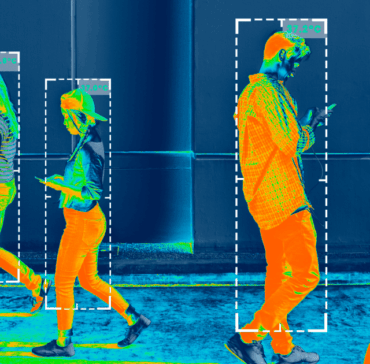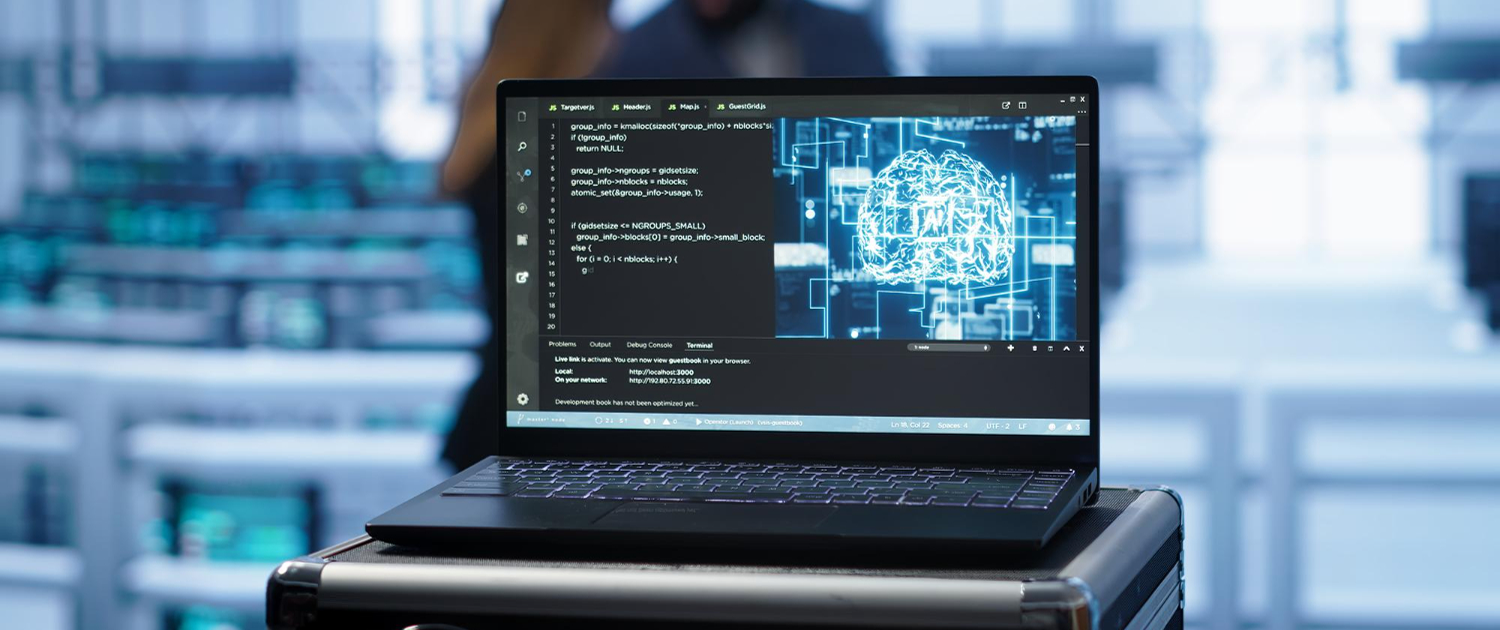
Many people do not even consider how much computer vision is now driving the processes of both ordinary people and businesses. It is in everyday products, apps, and industries: Face ID on your phone, self-driving cars, Google Photos, supermarket cameras, and more.
In this article, we will explore what computer vision is, how it works, who is using CV in 2025 and why.
What Is Computer Vision Software & How It Works
Computer vision is a field of artificial intelligence that enables machines to “see”, analyze, and extract meaning from visual data (images/videos) in a way that mimics human perception.
Computer vision is built on two main pillars:
- data (thousands or millions of labeled images)
- AI models (like neural networks)
When you show a photo from a security camera to a trained CV model, the system might say: “There’s a person walking in zone B, a forklift moving in zone C, and a helmet is missing on the worker in frame.”
This process happens as follows:
- The image is converted into a matrix of pixel values. A 224×224 RGB image becomes a 3D tensor of shape [224, 224, 3], where each value ranges from 0 to 255)
- The model detects low-level features (edges, corners, and textures)
- Combines them into high-level patterns (shapes or objects)
- The network forms a deep representation of the image, turning raw pixel data into meaningful semantic features.
- If it’s an image classifier, it outputs a label (“helmet”, “person”). If it’s an object detector, it outputs bounding boxes and classes (“person in area X”)
A computer sees an image as a giant grid of numbers – [[[123, 34, 98], [126, 36, 95], …], …], but by training on labeled examples, it learns to recognize meaningful patterns in those numbers (much like our brains recognize objects from patterns of light and shape).
Key Technologies Behind Computer Vision (CV)
Neural networks
The fundamentals of modern CV are Convolutional Neural Networks (CNNs). They learn to extract patterns (edges, shapes, objects) and use them for image classification, object detection, segmentation, and more.
We put CNNs to work in a real-life scenario, take a look at our case study to see how it translated into practical value.
Image processing techniques
Before feeding images into models, they’re often resized, cropped, denoised, and color-corrected. It may be old-school, but it still plays a key role in preparing high-quality data for AI training.
Object detection models
These are specialized architectures designed to detect multiple objects in a single image and draw boxes around them.
Some popular ones include:
- YOLO (You Only Look Once) – great for real-time detection
- Faster R-CNN
- SSD (Single Shot Detector)
Where you’ll see them in action: drones, self-driving cars, surveillance systems.
Vision transformers (ViTs)
A newer approach uses transformer architecture (like the one behind GPT) to help machines understand images.
You’ll find it powering multi-modal systems (image + text), image classification, and segmentation tasks.
Semantic & instance segmentation
Instead of “There’s a person” segmentation asks which pixels belong to the person (e.g. Mask R-CNN)
SLAM (Simultaneous Localization and Mapping)
SLAM helps machines understand and map the 3D world using cameras. It used in robotics, AR, autonomous navigation.
3D vision / depth estimation
These models estimate how far things are from the camera and the shape and structure of 3D environments. Used in self-driving, AR/VR, robotics, surgery.
Self-Supervised & Synthetic Data Training
Models learn from unlabeled data using clever tricks like contrastive learning, or train on synthetic/generated images.

Benefits of Computer Vision
Beyond the technical breakthroughs, computer vision delivers measurable value to businesses across sectors. Here’s what makes CV adoption a strategic advantage:
- CV eliminates repetitive visual tasks (quality control, counting inventory, or reading meters) allowing teams to focus on more complex work.
- With modern hardware, visual data can now be processed instantly, enabling systems to respond to events as they happen.
- Once trained, a vision model can operate 24/7 across thousands of locations, devices, or users (without additional cost per task).
- Vision models can run on phones, microcontrollers, or cameras without cloud reliance.
- CV enables entirely new services (for instance, AR try-ons in retail) that wouldn’t be possible otherwise.
Ultimately, businesses that embed computer vision solutions into their infrastructure unlock new capabilities, insights, and competitive edges.
Top Computer Vision Applications Across Industries
First, why CV is booming in 2025? There are two prerequisites for this:
- Modern devices (phones, drones, robots, AR glasses) can run vision models in real-time and we don’t need clouds anymore. This process became faster, cheaper, safer, and even more energy-efficient.
- Modern models can now understand scenes, follow instructions, track objects across time, and work across multiple tasks (recognize, segment, describe, detect, etc.) They are smarter than older ones and don’t need as much labeled data.
We can also observe how tech trendsetters are creating directions for the entire industries. To demonstrate it, we have outlined computer vision examples in some of the areas where the use of CV is most noticeable:
1. Computer vision in retail
Retail is one of the earliest and fastest-growing adopters of computer vision technologies, with the market reaching $1.06 billion in 2023.
If we are talking about in-store experience, CV can analyze customer behavior, monitor shelf stock, detect product placement, and optimize checkout lines, by enabling cameras and sensors.
CSO of Crunch.is has written an article about real life examples of computer vision use in brick-and-mortar stores, you can read it here.
At the same time, augmented reality (AR) try-on apps powered by CV allow shoppers to preview how clothes, glasses, or makeup will look on them using only their phone cameras.
2. Computer vision in mobility and transportation
The automotive industry increasingly depends on real-time insights from visual data to improve both operational efficiency and driver safety. Computer vision plays a critical role in enabling these advancements, particularly through Advanced Driver Assistance Systems (ADAS).
ADAS uses CV to detect lanes, pedestrians, traffic signals, and road signs, while also enabling functions like automatic braking, lane-keeping, obstacle avoidance, and assisted parking.
Unsurprisingly, the automotive and transportation sector accounted for $1.78 billion of the global computer vision market in 2023, reflecting strong demand for intelligent systems that enhance decision-making on the road.
3. Computer vision in manufacturing
As of 2024, the manufacturing segment of the computer vision market was valued at approximately $3 billion, accounting for over 20% of the global market share. This growth is fueled by the rising demand for automation, precision, and consistency in complex production environments where industrial computer vision systems play a central role.
Manufacturers are actively integrating AI-powered vision systems for a variety of mission-critical tasks:
- inspecting products on assembly lines in real-time
- detecting defects faster than human eyes, down to the micro-level
- tracking inventory with robotic vision systems to minimize human error
4. Computer vision in security & surveillance
Computer vision is rapidly transforming traditional CCTV into intelligent security infrastructure. Vision-enabled surveillance can now identify faces, detect suspicious behavior, recognize license plates, and even identify accidents, weapons, or fires within seconds. This technology dramatically improves response times and reduces human error.
A notable example of computer vision is a face detection and recognition project for a robotics company specializing in AI-powered security. We developed software that employs deep learning technology, empowering an autonomous robot to detect and recognize individuals, track movement, and identify spatial features such as gates. (The final solution was successfully showcased at a major tech conference and generated strong investor interest.)
5. Computer vision in agriculture
CV-powered tools are enabling a shift toward precision farming. Drones and smart imaging systems can now assess crop health, detect diseases early, and optimize the use of water and pesticides. These tools analyze plant coloration, leaf patterns, and soil conditions to flag signs of stress or nutrient deficiencies.
Moreover, automated systems can track growth patterns, estimate yield, and even assist in targeted spraying.
6. Computer vision in healthcare
AI-powered computer vision tools support doctors in delivering faster, more accurate treatment.
AI models trained on X-rays, MRIs, and CT scans can detect signs of cancer, fractures or eye diseases earlier than traditional methods. These systems act as intelligent assistants, helping radiologists reduce diagnostic errors and speed up workflows.
Computer vision also can track patient movement to prevent falls, monitor recovery progress, and alert staff in emergencies.
With the healthcare computer vision market valued at $1 billion in 2023 and projected to grow at a 34.3% CAGR through 2032, demand for precision AI diagnostics is only set to rise.
Computer Vision Challenges
Computer vision promises real value, but the road to adoption can be demanding. The technology is data-intensive and often requires advanced engineering to function at scale and in real-world conditions. Teams may face challenges with data quality, algorithm performance, edge deployment, or even organizational readiness.
Key challenges often include:
- data privacy and security (handling large volumes of visual data brings privacy, compliance, and cybersecurity to the forefront)
- system integration (CV systems often require integration with edge devices, IoT systems, and legacy infrastructure, which adds further complexity)
- technical complexity and scalability (building efficient, scalable computer vision pipelines demands expertise in AI, ML, and DevOps)
To overcome these challenges, you need a partner who understands both the technology and the business landscape.
With deep technical know-how and hands-on experience, we’re ready to guide your vision project from idea to implementation. Get in touch with us to start the conversation.
Conclusion
Computer vision has moved far beyond research labs and now plays a critical role in how modern technology sees, understands, and interacts with the world. From real-time object detection in autonomous vehicles to disease diagnosis in hospitals and smart retail experiences, CV is transforming industries at scale.
As hardware becomes more powerful and software more efficient, the barriers to building and deploying vision-powered systems are lower than ever.
Need help building a custom computer vision solution? Our computer vision experts specialize in developing scalable, AI-powered computer vision solutions tailored to your industry. Contact us today to discuss your project.

![How Much Does It Cost to Build AI Solutions In 2025 [Ultimate Guide]](https://crunch.is/wp-content/uploads/2024/06/steve-johnson-1FD-E7Ioblw-unsplash-scaled.jpg)





